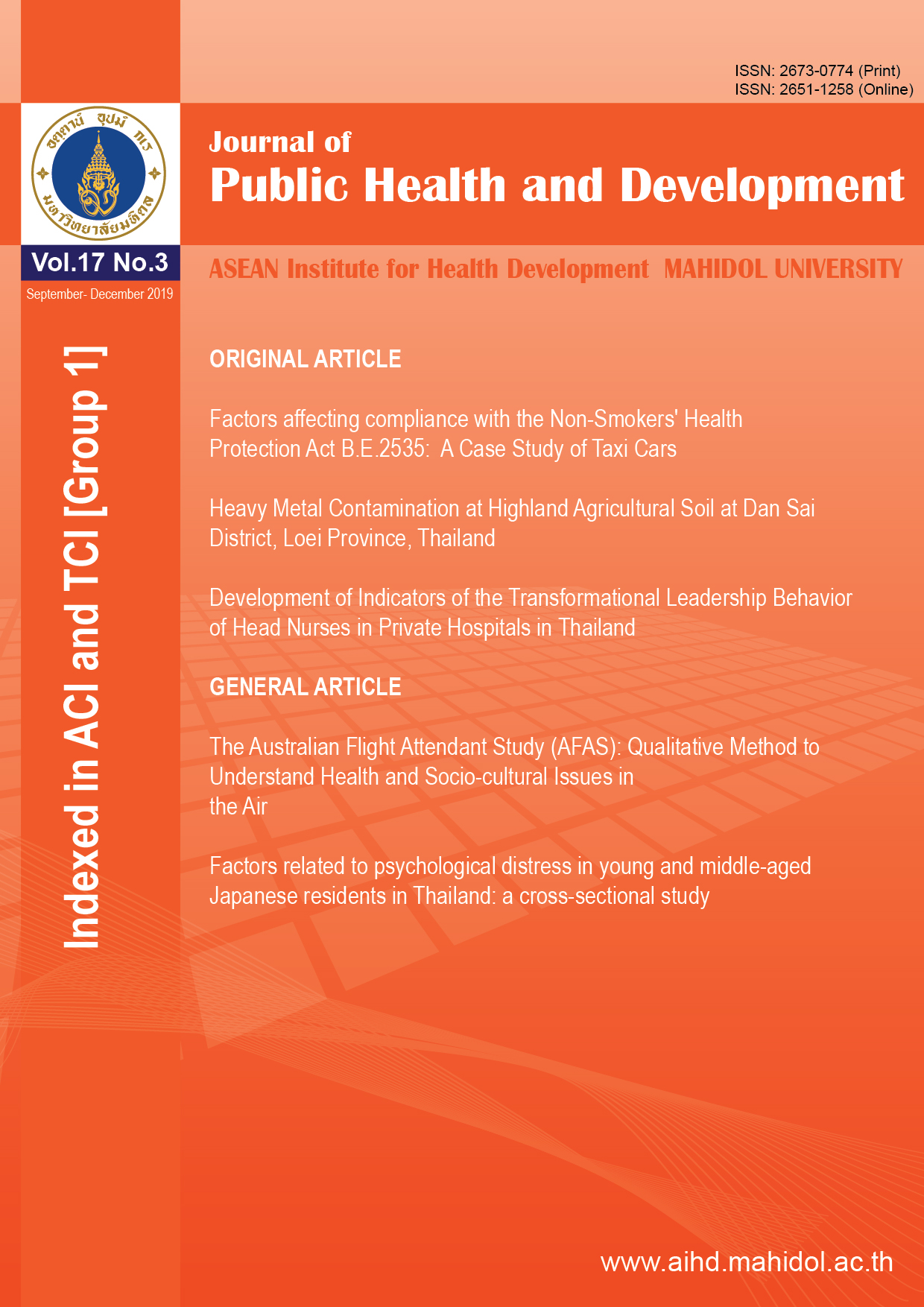Development of indicators of the transformational leadership behavior of head nurses in private hospitals in Thailand
Main Article Content
Abstract
Indicators of the transformational leadership behavior of head nurses in private hospitals in Thailand are a necessary tool to aid in the development of nursing organizations in the highly competitive field of private hospitals, especially in the area of nursing services which require innovation in services to respond to the demands of patients and family members.
This study developed indicators for transformational leadership behavior of head nurses in private hospitals in Thailand by using quantitative methods.The development of transformational leadership behavior indicators are presented as follows:1) definition of operational terms; 2) creation of questions from the definition of terms, which resulted in 65 indicators of 4 components; 3) content validity testing by five experts, with a CVI = 0.95; 4) determining the internal consistency reliability with thirty head nurses of nurses in private hospitals in Thailand, with a Cronbach’s Alpha Coefficient for inspirational motivation, individualized consideration, idealized influence, and intellectual stimulation were 0.96, 0.96, 0.93, 0.93, Overall reliability was 0.98; 5) testing of the construct validity by using factor analysis to extract indicators , with 205 head nurses in large private hospitals in Thailand.The research instrument for measuring transformational leadership behavior contained four components with a total of 38 indicators: 1) intellectual stimulation is composed of 10 indicators, 2) inspirational motivation is composed of 11 indicators, 3) individualized consideration is composed of 11 indicators, and 4) idealized influence is composed of 6 indicators.The developed instrument was congruent with empirical data (c 2 = .452.53, CMIN/DF =.868, CFI =1.000, GFI= .900, AGFI = .858, RMR=.015, RMSEA= .000,6) Cronbach’s alpha coefficient for reliability after construct validity for intellectual stimulation, inspirational motivation, individualized consideration, and idealized influence were 0.93, 0.92, 0.92, 0.87, and for overall reliability was 0.97.
The developed indicators can be used to measure the level of behavior of transformational leadership behavior of the head nurses and nursing administrators should use the information to develop transformational leadership behavior of the head nurses, especially inspirational motivation by making helping nursing team members see the future and talking about possible future images conditions.
Article Details

This work is licensed under a Creative Commons Attribution-NonCommercial-NoDerivatives 4.0 International License.
References
Yaghoubi H, Mahallati T, Moghadam AS, Fallah MA. Transformational leadership: enabling factor of knowledge management practices. JSSM 2014; 4(3): 165-174.
Ying, Ooihui. Transformational Leadership and Organizational Innovation: A Study of Mncs In Malaysia; 2009
Imran R, Anis-ul-Haque M. Mediating effect of organizational climate between transformational leadership and innovative work behaviour. Pakistan Journal of Psychological Research. 2011 Jan 1; 26(2): pp-183.
Aldeeb GA, El-Demerdash SM. Head nurses' transformational leadership, collaboration and its relation to staff nurses' work engagement. International journal of Nursing Didactics. 2016 Jul 31; 6(7):30-9.
Asif M, Jameel A, Hussain A, Hwang J, Sahito N. Linking Transformational Leadership with Nurse-Assessed Adverse Patient Outcomes and the Quality of Care: Assessing the Role of Job Satisfaction and Structural Empowerment. International journal of environmental research and public health. 2019 Jan;16(13):2381.
Gabel S. Transformational leadership and healthcare. Medical Science Educator. 2013 Mar 1;23(1):55-60.
Ghadi M, Fernando M, Caputi P. Transformational leadership, workplace engagement and the mediating influence of meaningful work: Building a conceptual framework; 2010.
Naseer A, Perveen K, Afzal M, Waqas A, Gillani SA. The Impact of Leadership Styles on Staff Nurses’ Turnover Intentions. IJARBS. 2017;7(12):665-73.
Bass BM, Riggio RE. Transformational leadership. Psychology press; 2006
Burns, N., & Grove, S. K. (2001). The practice of Nursing Research: Conduct, critique and utilization. (4th ed.). Philadelphia: W.B. Saunders. ; 2010
Comrey AL, Lee HB. A first course in factor analysis. Psychology press; 2013
Polit DF, Beck CT. Nursing research: Principles and methods. Lippincott Williams & Wilkins; 2004.
Yurdugül H. Minimum sample size for Cronbach’s coefficient alpha: a Monte-Carlo study. Hacettepe Üniversitesi eğitim fakültesi dergisi. 2008;35(35):1-9.
Best JW, Kahn JV. Research in education. Pearson Education India; 2016.
Lynn M. R. Determination and quantification of content validity. Nursing Research 1986; 35: 382-385.
Polit D. F., & Beck C.T. Essentials of Nursing Research: Appraising Evidence for Nursing Practice.(8th Ed). Philadelphia: Lippincott Williams, & Wilkins; 2014.
DeVellis, R.F. Scale Development: Theory and Application. 3rd ed. Thousand Oaks, CA: Sage; 2012.
Wanitbancha, K. Advanced SPSS Statistical Analysis. (9th Edition). Bangkok: Thammasarn Co., Ltd.;2011. (in Thai).
Tan J, editor. Advancing Technologies and Intelligence in Healthcare and Clinical Environments Breakthroughs. IGI Global; 2012 Jun 30.
Schermelleh-Engel K, Moosbrugger H, Müller H. Evaluating the fit of structural equation models: Tests of significance and descriptive goodness-of-fit measures. Methods of psychological research online. 2003 May 25;8(2):23-74.
Pituch KA, Stevens JP. Applied multivariate statistics for the social sciences: Analyses with SAS and IBM’s SPSS. Routledge; 2015 Dec 7.
Nunnally,J. C.Psychometric Theory. New York: McGraw-Hill; 1978.
Kittiranee Khuangporn, Shotiga Pasiphol. Development of 21st century Transformational Leadership Skill Scale for Undergraduate Students. Online Journal of Education. 2016; 11(2):131-46.
Leonard Ngaithe, George K’Aol, Peter Lewa and Michael Ndwiga. Effect of Idealized Influence and Inspirational Motivation on Staff Performance in State Owned Enterprises in Kenya. European Journal of Business and Management 2016; 8 (30) : 6-13

